Star Wars is often discussed in the context of the late seventies, whether the political context of the Vietnam War or George Lucas’ status as an up and coming director alongside the likes of Francis Ford Coppola or Steven Spielberg or even just the way in which it shifted movie-making away from the new Hollywood model towards the blockbuster template.
Despite all of this, it is often overlooked just how firmly Star Wars: Episode V – The Empire Strikes Back is rooted in the context of the early eighties. There are obviously any number of reasons for this. Most obviously, Star Wars: Episode VI – Return of the Jedi consciously retreated back to the late seventies trappings of the original film, right down to its decision to restage the Vietnam War with adorable toyetic teddy bears in the place of the Viet Cong. There’s also a sense in which the cultural markers of The Empire Strikes Back are more subtle than those of Star Wars.

Sabre-rattling.
Watched from a modern perspective, The Empire Strikes Back seems to herald the arrival of the new decade. Like all great sequels, it broadens both the scale and scope of Star Wars, but it also pushes the franchise forward. Even beyond the now iconic revelations about family lineage and power dynamics, The Empire Strikes Back radically redefines what it means to be a Star Wars film. It is no longer about navigating the moral ambiguity of an uncertain time, wrestling with the spectre of American might. It is instead about exploring social power structures, of finding one’s place in system.
The Empire Strikes Back might just be the first truly great eighties movie.

A little father-son outreach.
To be fair, The Empire Strikes Back was released in May 1980. It was a transitional period. Jimmy Carter still held the White House, but he was vulnerable; he had been historically unpopular the previous June. Although Ronald Reagan would not officially secure the Republican nomination until July, he had been “a clear front-runner” since at least the previous May. The looming election would retroactively be described as a “realigning election”, a radical redrawing of the American political map. It might not have been morning in America by May 1980, but dawn was breaking.
The seventies had been a turbulent decade for the United States. The country dealt with the legacy of Vietnam and survived Watergate. It dealt with the oil crisis and an economic recession. The traditional family unit strained, with the increase in two-income families leaving many children (relatively) unattended and the increased availability of no-fault divorce making it easier to dissolve the nuclear family. It is no surprise that the seventies saw a boom in horror films, tapping into these collective national anxieties.
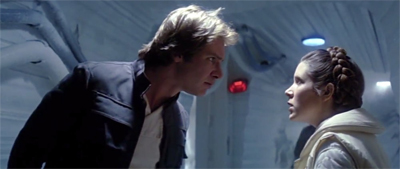
Some like it Hoth.
The original Star Wars played against that backdrop. Its “used future” aesthetic resonated with a country that was grappling with the tarnishing of the American Dream. Even the Death Star posed a quantifiable apocalyptic threat, with its capacity to literally blow planets out of the sky. The world of the original Star Wars seemed to be on the verge of falling apart; industrial dungeons moving on wheels across the surface of desert planets, garbage compactors crushing scrap metal in the bowels of a weapon of mass destruction, a failed smuggler in his beat-up freighter.
In contrast, the world of The Empire Strikes Back is a lot cleaner and crisper. The opening act swaps the hot sands of Tatooine for the cold ice of Hoth. The industrial surroundings of the Death Star have been replaced by the consistently sleeker and shinier interiors of Imperial Star Destroyers. There is no singular apocalyptic weapon of mass destruction, just a standard imperial fleet going about business as usual. Indeed, the opening scroll of The Empire Strikes Back affirms that the Empire has embraced automation, outsourcing a lot of the hunt for the rebels to probe droids.

Swamped with work.
Even Darth Vader himself received a minor redesign between Star Wars and The Empire Strikes Back, designed to make his costume look a little more polished and a little more clean. His shoulder pads are more pronounced. His central respirator looks more complex. His eyes are black and reflective, removing the red tint from the earlier film. At one point early in Empire, the audience gets to see Vader within his protective pod, a sharp contrast between black and white. This fits with the large aesthetic shift of the Empire within The Empire Strikes Back.
In Star Wars, Grand Moff Tarkin had been played by Peter Cushing. Cushing was a British character actor with a long and distinguished career. He was a commanding presence, cutting a distinctive figure and speaking with cold authority. In contrast The Empire Strikes Back presents a version of the Empire that is run by pencil-pushing bureaucrats. Outside of Darth Vader, imperial officials become interchangeable and generic. Admiral Piett survives until the end of Return of the Jedi, largely by keeping his head down. Few viewers could likely pick him out of a line-up.

Stars their destination.
In The Empire Strikes Back, the Empire becomes an organisation defined by its middle-management. It is a large and lumbering organisation that exists largely to squeeze the galaxy. As the title of Star Wars suggested, that first film presented the Empire as a planet-destroying monstrosity. In contrast, The Empire Strikes Back suggests that the organisation is more about control and order. Vader never threatens to destroy Bespin like Tarkin destroyed Alderaan, despite the fact that he has the strength the do so. Instead, he threatens to bring it under his heel.
This shift in the portrayal of the Empire in The Empire Strikes Back feels very much in step with eighties anxieties as America transitioned into the Reagan era. The eighties would become known as a decade of excess and crass consumerism, the so-called “decade of greed.” The eighties were the era of the hostile takeover and the corporate buyout, where corporate raiders rode freely, and when nobody seemed too care as long as everybody was making money. This anxiety permeated the science-fiction of the eighties, such as RoboCop or Aliens.
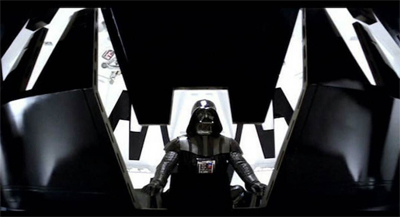
Polished exterior.
Of course, The Empire Strikes Back is a very different film than either RoboCop or Aliens. It would be hard to define it as a commentary on hypercapitalism. However, it does tap into some of the same anxieties, just from a different angle. In his book Sex, Drugs, and Cocoa Puffs, Chuck Klosterman argues that Luke Skywalker is the first Generation X protagonist:
… it’s clear that Luke Skywalker was the original Gen Xer. For one thing, he was incessantly whiny. For another, he was exhaustively educated – via Yoda – about things that had little practical value (i.e. how to stand on one’s head while lifting a rock telekinetically). Essentially, Luke went to the University of Dagobah with a major in Buddhist philosophy and a minor in physical education. There’s not a lot of career opportunities for that kind of schooling; that’s probably why he dropped out in the middle of the semester. Meanwhile, Luke’s only romantic aspirations are directed toward a woman who (literally) looks at him like a brother. His dad is on his case to join the family business. Most significantly, all the problems in his life can be directly blamed on the generation that came before him, and specifically on his father’s views about what to believe (i.e. respect authority, dress conservatively, annihilate innocent planets, etc.)
Klosterman might be slightly over-egging the pudding here, but there is a lot of truth to this characterisation of Luke. In particular, it’s notable that Luke’s aspirations to change the universe amount to nothing meaningful. In Star Wars: Episode VII – The Force Awakens and Star Wars: Episode VIII – The Last Jedi, his Rebellion appears to have failed to make any real difference.

Luking out.
It’s possible to frame this as a criticism of The Force Awakens and The Last Jedi rather than as a criticism of Luke Skywalker himself. That misses the point. While the production team working on The Force Awakens obviously just wanted to replay the conflict from the original Star Wars with minimal complications or nuance, Luke’s failure fits with two simple facts. Most obviously, the Star Wars saga is fundamentally about how all parents inevitably fail the next generation and Luke’s “redemption” of his father in Return of the Jedi was primarily about making himself feel good.
This gets at some of the anxieties that would come to define Generation X, the children born roughly between the mid-sixties to the mid-to-late seventies. These children would have come of age with Star Wars. Even if Mark Hamill was too old to have been a member of Generation X, Luke Skywalker arrived at just the right time to imprint himself upon those impressionable young audience members. His journey would have resonated with them, even if they themselves had yet to face the challenges confronting him.

Going by the book.
Generation X arguably got lost in the gap between generations. Modern generational conflict is defined by the relationship between baby boomers and millennials. They have been described as “America’s forgotten middle child.” It could be argued that – despite working hard and consistently – they are destined to be forever overlooked. Kamala Harris recently dropped out of the Democratic primary, and with her one of the last chances for a member of Generation X to become President of the United States.
The conflict at the heart of The Empire Strikes Back speaks to that generational divide. Darth Vader is planning a hostile takeover of the Empire, ousting the sitting Emperor and turning it into something resembling a family business. He asks Luke to support him, to come back into the fold, to put away his lightsabre and make a difference to how things operate. “You can destroy the emperor,” Vader assures his son. “It is your destiny. Join me and together we can rule the galaxy as father and son.”

All the best Jedi have daddy issues.
Luke does not accept that offer to sell out and become part of the very apparatus against which he has taken up arms. However, Luke also doesn’t respond by fighting back. Instead, confronted with the inevitability of his defeat and the realisation that he cannot defeat the overwhelming power of his father’s ambitions, Luke essentially gives up. He drops from Bespin. Mark Hamill famously objected to the addition of a scream to early remasters of The Empire Strikes Back, because – as Hamill saw it – “it’s like he’s committing suicide.” Luke is literally dropping out.
It’s a powerful and striking conclusion, and one which resonates with the larger myths of Generation X – the idea that they represent “a bleak dropout culture”, seen as “a lost generation” with “few heroes, no anthems, no style to call their own.” The battle at Bespin leaves Luke traumatised, lying in bed, cradling an amputated limb as evidence of a symbolic castration at the hands of a father who had lost all patience for his listlessness. Luke even confronts betrayal by his benign father figures, asking why Obi-Wan (and also implicitly Yoda) lied to him.
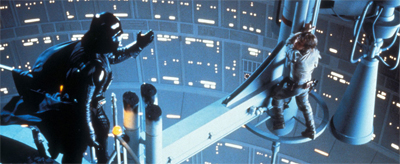
Reaching out across the generational divide.
However, the eightiesness at the heart of The Empire Strikes Back arguably finds its best expression on Bespin with the character of Lando Calrissian. Lando is a manipulative scoundrel who has somehow found himself in charge of a mining colony. Of course, the audience doesn’t actually see any mining on Bespin. Bespin is probably the most luxurious location in the original trilogy. It is clean, it is shiny, and it is populated by people who actually want to be there.
Theoretically, Bespin is similar to any of the other industrial settings from the original Star Wars like Tatooine or the Death Star. However, The Empire Strikes Back suggests that Cloud City has painted over these industrial processes with a more warm and welcoming veneer. Lando is introduced as an old acquaintance of Han, but he has made himself respectable. He dresses nicer, he is accompanied by staff, he has transformed himself from a smuggler into a legitimate businessman. “You sound like a businessman, a responsible leader,” Han states, surprised.
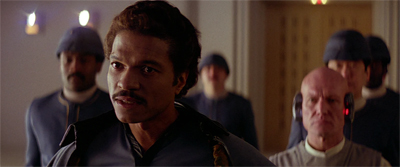
Sticking the Lando.
Lando has reinvented himself for a new era. “Yeah, I’m responsible these days,” he tells Han. “It’s the price you pay for being successful.” There is a sense in which Lando has sold out in the way that Vader clearly wants for Luke. Lando was an untrustworthy rogue, but now he’s just a man looking out for all his employees. Lando is presented as something close to the ideal of a small business owner. He is a responsible individual who just wants to run his corner of the universe with minimal outside interference.
“You see, since we’re a small operation we don’t fall into the jurisdiction of the Empire,” Lando explains. Han asks, “Aren’t you afraid the Empire’s gonna find out, shut you down?” That fear is very real for Lando, to the point that he betrays Han in order to protect Bespin. It is no surprise that some business bloggers have even embraced the idea of Lando as an allegory for small businesses trying to navigate relationships with more powerful entities. (On that note, Vader also drafts in independent contractors to help hunt down the Millennium Falcon; outsourcing.)
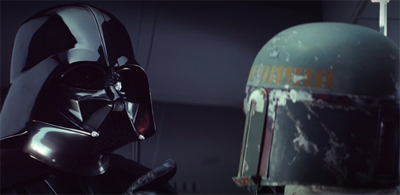
Bounty Law.
Lando seems to fighting to keep the heel of the Empire off his neck. Lando’s actions are treated largely as commerce. He describes his “deal” and his “arrangement” with Darth Vader, who has even arranged a very dramatic confrontation with Han and Leia in order to demonstrate the perceived civility of Bespin; Vader waits to greet them in a dining room with a banquet table already set. Lando and Cloud City seem to speak to certain core myths of the eighties.
If Lando is a small business owner, he is decrying heavy government regulation. He seems to have been spurred to action in part by the revelation that Vader intends to leave a “garrison” on Cloud City full-time, to supervise his activities. This reflects certain anxieties of the Reagan era, most notably the assertion that “government is not the solution to [the] problem; government is the problem.” Reagan famously argued for a reduction in government regulation and a cut in taxes. While nowhere near as dramatic as the drama in Cloud City, one imagines Lando would empathise.

This is what happens when you get tenure.
However, something more subtle and interesting happens after Lando surrenders the crew of the Millennium Falcon to Darth Vader. The Empire Strikes Back reveals that Cloud City has a dark underbelly. Although it is first explored by C-3PO and Chewbecca, Han and Leia also find themselves imprisoned there. This section of the city is quite different from the glamourous upper levels. It looks much more like the industrial designs of the original Star Wars, with dungeons and conveyor belts.
The climax of the film suggests that this is the literal underbelly of Cloud City. Luke fights Vader through the industrial bowels of the city before finding himself dangling from an antenna at the bottom. While there are stark differences between the polished exterior of the upper levels and the grim lower levels, they are clearly unified. The production design and the direction consciously mirrors them. The bars at the top of the dungeon are designed to evoke the skylight in Han and Leia’s glorious penthouse apartment.

Don’t leave him hanging.
Again, this seems to prefigure certain anxieties that would come to define the Reagan era, particular within the horror subgenre. Movies like Nightmare on Elm Street and They Live! offered biting social commentary of the period by contrasting successful and appealing exteriors with the monstrosity that was lurking underneath. Cloud City looks much nicer than many of the other locations within the original trilogy, but that is just a façade. Beneath that beautiful design there is something deeply horrific just waiting to be revealed.
Indeed, The Empire Strikes Back even frames this revelation in a way that recalls classic horror movies. During Lando’s tour of the station, C-3PO separates himself from the group to investigate something on his own. The camera follows C-3PO quite closely as he journeys into the heart of the station. In order to preserve the surprise of Vader’s arrival a few scenes later, the audience does not get to see the darkness nestled at the heart of the floating city. (It turns out that C-3PO saw stormtoopers, because the Empire’s reach is inescapable.)
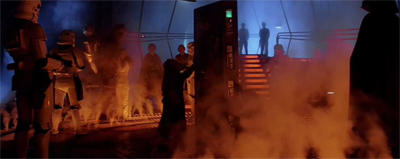
Frozen in time.
The Empire Strikes Back is arguably the best film in the larger Star Wars franchise. This is because it is willing to play with slightly more ambitious ideas than the original Star Wars in slightly more compelling ways. Star Wars spoke to the longings and desires of the late seventies, of a fantasy that a nation needed after a decade of trauma. In contrast, The Empire Strikes Back arrived clued in to a decade that was only just getting started.
It seems highly unlikely that all of these elements were consciously designed to resonate with the current moment. After all, Ronald Reagan wasn’t even officially the Republican nominee by the time that the film was released, and there was no way to know exactly how he would govern if he did happen to win the election. Instead, The Empire Strikes Back seems tied into the same zeitgeist that Reagan rode to power, to the aspirations of those who supported him and to the fears of those who worried what it might mean.

Facing his father.
Indeed, it is notable that Return of the Jedi arguably embraces the aesthetic and mood of the eighties in a much more concrete and much less anxious manner. If The Empire Strikes Back is wary about the emergence of the values and beliefs that would come to define the popular idea of the eighties, Return of the Jedi embraces them completely. In The Empire Strikes Back, Luke refuses to join Vader in a plot to kill the Emperor. In Return of the Jedi, Luke risks a vital rebel mission in order to reunite and redeem his father, which inevitably involves killing the Emperor.
In Return of the Jedi, Luke sells out. He just doesn’t put that label on it. Luke insists that there must be good within Vader, despite the complete lack of evidence supporting that hypothesis. Return of the Jedi than assures its audience that Luke has redeemed Vader, despite the fact that Vader does nothing to merit redemption. Vader does not halt the Battle of Endor, he does not destroy the Second Death Star, he doesn’t even call off the ground forces on the moon. Vader simply does what he promised to do in The Empire Strikes Back: he kills his boss.
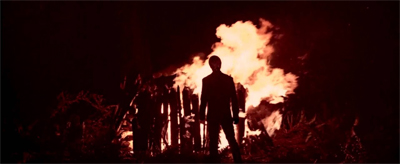
Rekindling their relationship.
This all makes The Empire Strikes Back an even more compelling and engaging film. The Empire Strikes Back somehow manages to get a strong read on a decade that was only just beginning.
Filed under: On Second Thought | Tagged: anxiety, big business, boomers, cloud city, Darth Vader, economy, eigthies, fear, generation x, greed, lando calrissian, Luke Skywalker, prosperity, regulation, Ronald Reagan, small traders, star wars, the empire |




















There’s a decent argument in the “Star Wars And Philosophy” book that Lando is actually one of the more admirable characters in the series, precisely because he’s responsible and because of how he relates to that. As Cloud City administrator it’s his job to put his people first, and that’s exactly what he’s doing when he agrees to the Empire’s “deal” instead of putting his personal friendships first. As soon as it becomes clear that the “deal” isn’t one and that his people are screwed no matter what, he gives the evacuation signal and then immediately sets out to undo the damage he’s done to his friends – something that carries over into the next movie when he infiltrates a gangster fortress and risks his life. He’s not a bad guy, he’s an ordinary guy who’s been dealt a shitty hand, but still plays it as well as he possibly can in juggling his various personal and professional obligations.
Truthfully I don’t know if I *entirely* like this take – if only because it overlaps unpleasantly with the “it was all to save the French people!” narratives that Vichy apologists have been spinning for seventy years. But it’s an interesting take all the same. Lando is probably the only person in the original trilogy who feels like a real person instead of a sci-fi fantasy character, because he actually has a day job with those sort of unheroic duties he has to take into account before doing anything.
Yep. Lando feels like a three-dimensional human being rather than an archetype. This is what makes him so fascinating and compelling. Well, that and the charm of Billy Dee Williams.